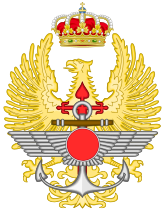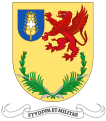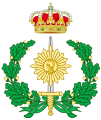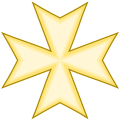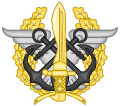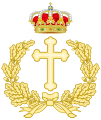-
Emblem of the Spanish Armed Forces (FAS)
Spanish military units have coats of arms, badges and emblems to distinguish them from other units both joint Armed Forces and service branches units.
The first evidence of medieval coats of arms is found in the Bayeux Tapestry from the 11th century, where some of the combatants carry shields painted with crosses. Coats of arms came into general use by feudal lords and knights in battle in the 12th century. By the 13th century arms had spread beyond their initial battlefield use to become a kind of flag or logo for families in the higher social classes of Europe. The use of arms spread to Church clergy, and to towns as civic identifiers, and to royally-chartered organizations such as universities and trading companies. In the 21st century, coats of arms are still in use by a variety of institutions and individuals. Military coats of arms and emblems were first required in navies and air forces to recognize naval fleets and squadrons. Nowadays Spanish military insignia are used for official wear or display by military personnel and Armed Forces units and organizations, including branches, commands, cops, brigades, divisions, regiments, battalions, centres et cetera.
Vicente de Cadenas y Vicent (1915–2005), Chronicler King of Arms of Spain, said military objects and natural figures are the most common heraldic charges used in Spanish Armed Forces heraldry. Chimeric figures are also used but they are uncommon. Mister Cadenas y Vicent also noted there are too many wrongly located charges in Spanish military escutcheons.[1][2]
-
Coat of Arms of the Joint Forces General Staff of the Armed Forces (EMAD)
-
Coat of Arms of the Operations Command
(MOPS)
EMAD -
Coat of Arms of the Armed Forces Intelligence Center (CIFAS)
EMAD -
Emblem of the Joint Cyberspace Command (MCCE)
EMAD -
Coat of Arms of the Joint Special Operations Command (MCOE)
EMAD -
Coat of Arms of the Health Operating Command (JESANOP)
EMAD -
Coat of arms of the Armed Forces Verification Unit (UVE)
EMAD -
Coat of Arms of the Armed Forces Communications and Information Systems Command (JCISFAS)
EMAD -
Coat of arms of the C-IED National Component (CENCIED)
EMAD
-
Coat of Arms of the Defence Medical Inspector General's Office (IGSD)
-
Coat of Arms of the Defence Military Pharmacy Center (CEMILFARDEF)
IGSD -
Coat of Arms of the Defence Institute of Toxicology (ITOXDEF)
IGSD -
Coat of Arms of the Defence Institute of Preventive Medicine (IMPDEF)
IGSD -
Coat of Arms of the Military Blood Transfusion Center (CTFAS)
IGSD -
Coat of Arms of the Military Veterinary Center (CEMILVET)
IGSD
-
Emblem of the Military Construction Service
-
Coat of Arms of the Defence Cataloging Service (SERDEF)
-
Emblem of the Operations Research Service
-
Emblem of the Defence Statistical Service
-
Coat of Arms of the Register Office of Armed Forces Professional Associations (RAPFAS)
COPERFAS
-
Coat of Arms of the Central Defence Academy
(ACD)
-
Coat of Arms of the Medical School (EMISAN)
Central Defence Academy -
Emblem of the Military Audit Corps School
(EMI)
Central Defence Academy -
Coat of Arms of the Military School of Legal Studies (EMEJ)
Central Defence Academy -
Coat of Arms of the Military School of Music (EMUM)
Central Defence Academy -
Coat of Arms of the Military School of Education Science (EMCE)
Central Defence Academy -
Coat of Arms of the Military School of Languages (EMID)
Central Defence Academy
-
Emblem of the National Defence Studies Centre (CESEDEN)
-
Emblem of the Armed Forces Higher Staff College (ESFAS)
CESEDEN
-
Coat of Arms of the Military Jurisdiction
-
Coat of Arms of the Canary Islands Joint Command
(MACOCAN)
Proposed Unit
-
Emblem of the Military Medicine
(Common) -
Emblem of the Military Medicine
(Ornamented) -
Emblem of the Military Legal Corps
-
Emblem of the Military Audit Corps
-
Emblem of the Military Bands Corps
-
Emblem of the Joint Special Operations Command (MCOE)
-
Emblem of the Military Archbishopric
-
Badge of the Royal and Military Order of Saint Ferdinand
-
Badge of the Royal and Military Order of Saint Hermenegild
-
Emblem of the former Higher Defence Studies College (EALEDE)
CESEDEN
-
Emblem of the former Defence High Command (AEM)
Until 1975 -
Emblem of the former Defence High Command (AEM)
1975-1980 -
Emblem of the former Board of Joint Chiefs of Staff (JUJEM)
1980-1984
- ^ Cadenas y Vicent, Vicente de (1994). Fundamentos de heráldica. Madrid: Hidalguía. ISBN 84-87204-64-3.
- ^ What is Heraldry? Archived 2013-01-17 at the Wayback Machine. The Institute of Heraldry. US Army, accessed 9 January 2013.
